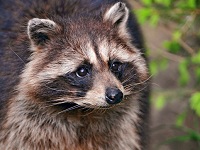Racoons (Procyon lotor)

I. Where They Live:
- Usually found in areas with tree and water
II. Reproduction and Habit:
- Females will birth 2-6 young after mating in January-February
III. What They Eat:
- They are omnivors feeding on plants and animals
IV. Diseases They Carry:
- Roundworm
V. Insect Vectors:
- Mites
VI. Why would a racoon be in an attic?:
- Females will nest in attics to protect their young
VII. Evidence that racoons are in an attic:
- Disturbed or "tunneled" insulation
VIII. How do they gain entry:
- They can gain entry through any opening their heads fit through
IX. Controls:
- Humane trapping and relocating
- Ground burrows, brush piles, rock crevices
- In the home in attics, crawlspaces, chimneys, under decks and patios
- Gestation is 2 months with young born in March-April
- Young become active after 2 months and will begin to search for food
- Females will travel 2-6 miles and males 3-20 miles
- Females will become aggressive to protect young against predators and male racoons
- Noctural animals becoming active from 9:00 pm-dawn
- Eat grubs in lawn and vegetables
- Usually attracted to trash cans containing food wastes
- Distemper
- Rabies
- Ticks
- Fleas
- Lice
- Conenose bugs
- Area close to food source
- Chewed wires
- Droppings
- Usually in one area as opposed to randomly throughout
- They can rip into roof's overhangs, shingles, gable vents, chimney crevices and where two roofs meet
- Great climbers that can access roofs by climbing up wood siding, stucco, brick and from tree limbs
- Inspecting and identifying entry points to be excluded
Click on an icon to learn more about the pest.









